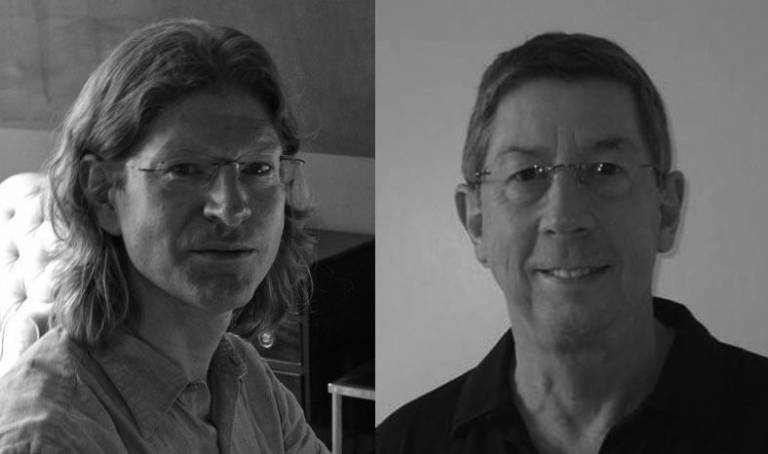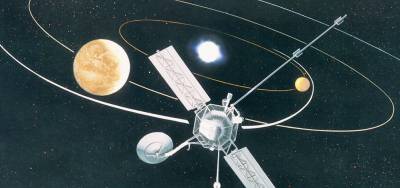UCL scientists recognised in IOP awards
1 July 2015

Two UCL scientists, Geoff Thornton and Chris Pickard, have been recognised in this year's Institute of Physics awards.
Left: Chris Pickard; Right: Geoff Thornton
Rayleigh Medal
Prof Chris Pickard (UCL Physics & Astronomy and London Centre for Nanotechnology)
"For his development of new theories and computational tools for the first principles investigation of matter, which have greatly aided the interpretation of magnetic resonance experiments, have revealed a range of unexpected phenomena in materials at extreme pressures, and increasingly underpin computational materials discovery."
Christopher Pickard is internationally renowned for his development of novel theoretical and computational tools for probing matter at the atomic scale. Based on first principles quantum mechanics, these tools are now used by theorists and experimentalists worldwide. His techniques for searching for unknown structures of materials and for interpreting magnetic resonance spectra have attracted particularly great international attention.
The question behind structure searching is among the most fundamental in all of physics: for a given assembly of atoms, how do those atoms arrange themselves? The long-sought answer is the key to the design of new materials, the understanding of matter at extreme conditions, the fabrication of nanostructures, and much else besides. Pickard's solution to the challenge, known as Ab Initio Random Structure Searching (AIRSS) is simpler than any other yet proposed, easier to use, and highly effective in practice. Simple though it is, AIRSS has yielded many remarkable discoveries over the past seven years, including new phases of hydrogen, an ionic form of ammonia, structural complexity in aluminium, and the prediction of magnetism in alkali metals. The power of AIRSS is helping to drive the new experimental-theoretical field of materials science at extreme (terapascal) pressures.
Close collaboration between theory and experiment has also inspired Pickard's innovative techniques for predicting nuclear magnetic resonance (NMR) and electron paramagnetic resonance (EPR) spectra in solids. NMR has long been a routine experimental technique for probing the local environment of atoms in solids and molecules, but the interpretation of NMR spectra is not always easy. Pickard's technique for the first principles prediction of NMR spectra, developed with Francesco Mauri, has greatly improved the extraction of information from experimental data, playing a key role in the development of what has become known as "NMR crystallography".
Tabor Medal
Prof Geoff Thornton (UCL Chemistry)
"For his contributions to understanding the physics and chemistry of oxide surfaces, using both scanned-probe and reciprocal-space techniques."
Geoff Thornton's work on the surface chemical physics of metal oxides has played a significant role in establishing the field, pioneering the link between a surface's electronic and atomic structure and its reactivity. In so doing he has consistently been at the forefront of instrument developments, most notably those involving synchrotron radiation techniques and scanning probes, particularly Scanning Tunnelling Microscopy (STM) and Non-Contact Atomic Force Microscopy. Indeed, it has been the combination of these two approaches that has been so very powerful.
The breakthrough came with the first representative atomically resolved images of a metal oxide surface. These were of ordered O vacancies on the (100) surface of TiO2. His group's seminal paper in 1995 on what has become the model oxide surface, TiO2 (110), described all the major elements present on that surface as a function of O vacancy density. Defects on oxide surfaces have long been thought to be involved in determining their reactivity; by monitoring the reaction of H2O with TiO2 (110), Thornton's group was able to observe, for the first time, bridging OH species being formed by dissociation of water molecules at O vacancies. In a form of single-molecule chemistry, his group observed individual vacancies being transformed into OH as a water molecule dissociated in the vacancy.
More recently, in another significant breakthrough, they distinguished vacancies and OH groups (which appear similar in STM images) from one another. They also associated these species with electron trapping centres that give rise to a bandgap electronic state - a discovery that transforms the understanding of the surface's reactivity.
Taken together, this body of work is a cornerstone of our modern understanding of the role of defects in the reactivity of the model photocatalyst TiO2, with wide implications for general models of catalysis and for potential future energy conversion technologies.
 Close
Close




